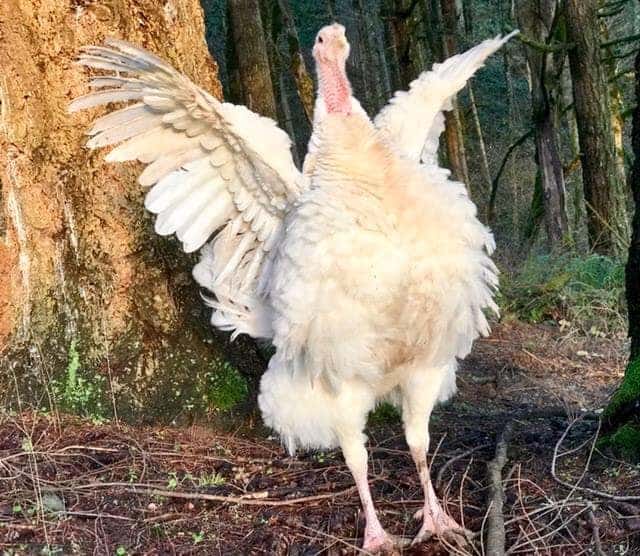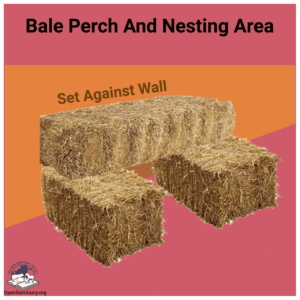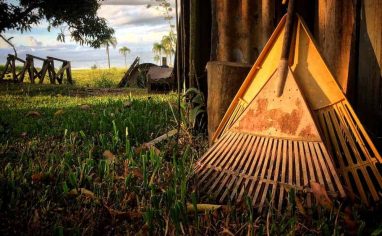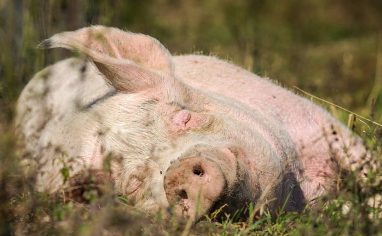
This resource has been fully reviewed and updatedA member of The Open Sanctuary Project’s staff has given this resource a full review and provided updates where necessary. by a member of The Open Sanctuary Project as of October 27, 2025. It was originally published on January 21, 2020.
Highly Pathogenic Avian Influenza
Given the increased risk of highly pathogenic avian influenza (HPAI) in recent years, turkeyUnless explicitly mentioned, we are referring to domesticated turkey breeds, not wild turkeys, who may have unique needs not covered by this resource. resident living spaces should be designed with HPAI protection in mind. Be sure to learn about how this disease is transmitted, and take steps to create living spaces that include protective measures. As the risk in your area changes, your residents’ living spaceThe indoor or outdoor area where an animal resident lives, eats, and rests. may need to provide more protection than it currently does. Planning ahead and considering how you would increase the level of protection the living space provides, should you need to enact enhanced biosecurityMerck Veterinary Manual defines biosecurity as ”the implementation of measures that reduce the risk of the introduction and spread of disease agents [pathogens].” measures, can help you respond quickly to an outbreak in your area. Please check out our detailed resource on HPAI for more information about transmission and how the living spaces you provide can reduce your residents’ risk of exposure.
Like most animals, turkeysUnless explicitly mentioned, we are referring to domesticated turkey breeds, not wild turkeys, who may have unique needs not covered by this resource. need an indoor shelter to keep them safe and comfortable, as well as ample outdoor space in which to explore, soak up the sun, and dust bathe. One sanctuary’s turkey living spaces might look quite different from another’s, but there are some important things to keep in mind when considering turkey resident housing. Also note that differences in the care large breedDomesticated animal breeds that have been selectively bred by humans to grow as large as possible, as quickly as possible, to the detriment of their health. and non-large breedA domesticated animal breed that has not been specifically engineered to grow as quickly as possible for the purpose of human consumption. In resources at The Open Sanctuary Project, "Heritage" breeds of turkeys, for instance, are "non-large breed", even if they are physically quite big. turkeys need can impact the type of housing they require. You can read more about the unique needs of large breed turkeys here. While predators can be a concern for mammalian residents, turkeys and other bird species are particularly vulnerable, making it crucial to keep predator-proofing at the forefront when designing both indoor and outdoor spaces.
In addition to the considerations discussed below, we recommend checking out our resource on animal-centered design and considering ways to incorporate this into your design process!
Keep It Safe!
If you are bringing new turkey residents into your life, you also need to ensure that you have an appropriate quarantine space to keep you and your existing residents safe!
Indoor Living Spaces For Turkeys
Sharing Your Home With Turkeys
This section is geared toward settings where turkey residents have their own housing that is separate from their human caregiver’s dwelling. While some of the information in this resource can certainly be applied to settings where turkeys spend time in their caregiver’s home, that living arrangement involves additional considerations not covered below. We do not currently have a resource on this subject, but if you’re looking for more information, please check out our resource, Sharing Your Home With Chickens. Much of the information contained in that resource can also be applied to turkeys.
Turkeys require access to indoor living spaces to ensure their comfort and safety. A barn, shed, garage, or similar structure can make a suitable indoor living space for turkeys so long as certain guidelines are followed.
The indoor space must:
- Provide robust protection from predators
- Provide enough space for normal activity and healthy social dynamics
- Provide appropriate traction and be easy on the feet and joints
- Be able to maintain a safe temperature and provide proper ventilation year-round
- Provide opportunities to exhibit natural behaviors
Up next, we’ll look at some of the various components and considerations for indoor living spaces.
Predator-Proofing
Turkeys are prey animals and are very vulnerable to predation, especially overnight. Therefore, a critical aspect of turkey care involves protecting them from predators, and the housing you provide plays a major role in accomplishing this. To provide your residents with robust predator protection, it’s important to start by considering the predators in your area so you can ensure you are taking appropriate measures to protect your residents. No matter where you live, predation is a real concern that must be taken seriously – just because you have not seen or heard about predators in your area does not mean they are not there. If you care for turkeys, you absolutely must work under the assumption that there are predators in your area.
While diurnal predators certainly pose a threat to turkey residents, the period from dusk to dawn poses a particularly significant risk. Some predators are primarily nocturnal, but other species may adapt their behavior to avoid humans, coming out during the nighttime hours, which are often devoid of human presence. Additionally, turkeys do not see well in the dark, making them much more vulnerable to predators overnight. For these reasons, turkey residents should be closed inside a fully predator-proof indoor space before dusk, and they should not be let out until it is light out. Please check out our resource, Predator-Proofing For Bird Residents, to learn how to create predator-proof living spaces and for tips on other measures you can implement to protect your residents. Gaps as small as a US quarter could allow certain predators to gain access to your residents, so careful construction and/or fortification of living spaces is imperative.
Rats
In addition to the typical predators that may come to mind, you also need to protect the turkeys in your care from rats. Rats can mortally injure turkeys by biting them as they sleep and are often one of the biggest risks to turkey residents, so be sure to take necessary precautions to deter them. Do not wait until you see rats to take steps to protect your residents! You can read about compassionate wildlife practices, including compassionate tips for deterring rats, here.
Size
It’s important to provide your turkey residents with enough space, but how much space is enough? There are many factors to consider when determining how much space individuals need, so unfortunately, there is no magic number we can offer. While there are plenty of recommendations out there about how much space turkeys “need,” many of these recommendations are coming from people who, even if they genuinely enjoy caring for turkeys, still view them as a commodity. And what does “need” even mean? At a sanctuary, we should consider what residents need to thrive, not just survive.
When considering how much space your residents need to thrive, you need to understand the species in general, as well as the unique individuals in your care. Depending on each individual and the dynamics of the flock, general recommendations offered online or even those offered by established sanctuaries may not be adequate. It’s also important to consider your climate and how much time you anticipate residents spending indoors. For example, in colder climates, particularly where residents may need to be restricted indoors for their safety, you’ll need to make sure they have enough indoor space for normal daytime activities. In this situation, turkey residents will likely require more indoor space than in settings where the climate is more temperate and residents are primarily using indoor spaces for sleeping. However, a very large space, especially one with a high ceiling, can be harder to keep warm in cold weather than a smaller one, so determining the most appropriate size can be a bit of a balancing act.
It is difficult to find non-industry recommendations about the amount of space turkeys require. We’ve gathered recommendations from Farm Sanctuary and Global Federation Of Animal Sanctuaries to give you a starting point when thinking about how much space your residents need. Keep in mind these are minimums and may not be sufficient for everyone.
- Farm Sanctuary’s 2018 Farm AnimalA domesticated animal that is used by humans either for their body or what comes from their body. Farmed animals have fewer regulations governing their welfare than other species in many countries. Care Conference materials recommend a minimum of 15 square feet per bird.
- Global Federation of Animal Sanctuaries’ Standards For Ground Feeding Bird Sanctuaries, which covers a wide range of bird species of various sizes (ranging from small buttonquail to large ostriches), recommends a minimum of 4 square feet of open floor space per medium bird and 10 square feet of open floor space per bird for larger species.
Use these as a starting point, but be aware that there are many factors to consider when determining the amount of space needed to keep your residents comfortable and happy. An individual’s age, breed, health, and activity level can impact the amount of space they require, as can flock dynamics and your climate.
Flooring And Bedding
Flooring for turkeys must provide appropriate traction and be easy on the joints. This is especially important for large breed turkeys, who are predisposed to developing various foot and joint issues due to their larger size. As mentioned above, predator-proofing is critical. When considering flooring options for indoor living spaces, you must factor in the degree of predator protection they provide. Concrete, wood, and packed dirt are common types of flooring used in turkey living spaces. Each type of flooring comes with its own pros and cons and may require modifications to make it appropriate for your residents.
Also, Keep Cleaning In Mind
In addition to considering a flooring option’s ability to protect against predators and provide appropriate traction and cushioning, you should also think about how easily it can be cleaned and disinfected.
Concrete provides good protection from predators, but on its own may not provide enough traction and may be too hard, particularly for large breed turkeys. The amount of traction concrete flooring provides is affected by how smooth or textured it is. A smooth concrete floor will not provide much traction at all, and depending on the type of bedding used, it could be far too slippery for residents to walk safely. While a textured concrete floor will provide more traction, heavily textured concrete can be abrasive and cause damage to foot pads, putting residents at risk of developing bumblefoot. Non-large breed turkeys, especially smaller hens, may do fine with a slightly textured concrete floor so long as it is topped with an appropriate amount of bedding, but for large breed turkeys, concrete flooring may be too hard on their feet and joints.
To make concrete flooring more appropriate for large breed turkeys or other turkey residents who need more traction or cushioning, you can lay textured rubber stall mats or interlocking foam mats on top of the concrete. While concrete is typically fairly easy to clean and disinfect (especially when compared to other flooring options), the addition of stall mats can make the cleaning process more difficult and labor-intensive.
Some prefab structures come with thin wood flooring. Wood floors do not provide the same degree of predator protection because they can be chewed through and may warp or rot over time, creating breaches that predators can enter through. Wood floors can be fortified with sheet metal or galvanized hardware cloth, but will require close observation and routine maintenance to ensure continued protection. Depending on the bedding used, wood flooring also may not provide enough traction, especially when wet, and wood floors can also be more difficult to clean and disinfect than concrete.
Dirt flooring can provide good traction and can be easier on the feet and joints, but, on its own, will not provide any protection from digging threats. Therefore, it must be used in conjunction with other predator-proofing methods. Options include adding a thick layer of dirt on top of concrete flooring or another predator-proof barrier, or it can be used in conjunction with concrete trenching to prevent anyone from digging into the living space. Dirt floors are difficult to clean and disinfect, and the dirt will erode as the space is cleaned, so they require regular maintenance to keep floors even. The dirt can also become so firmly packed that it no longer provides much cushion. The regular addition of more dirt can help remedy this issue.
Regardless of the type of flooring used, turkeys will also need ample amounts of dry bedding. Straw and wood shavings are common options. The use of straw carries an increased risk of aspergillosis, so it may not be appropriate depending on environmental factors and your residents’ overall health. If you opt for wood shavings, look for “low dust” or “dust extracted” types to promote healthy air quality. Aspen and pine wood shavings are popular options, and while we’ve talked to many sanctuaries that use pine shavings with no issues, be aware that there is conflicting research regarding whether or not pine shavings are entirely safe to use around birds. Cedar wood shavings should never be used because they can cause severe respiratory issues.
Perching And Nesting Opportunities
Instinctively, turkeys want to perch up off the ground to sleep because this is what their wild cousins do to help protect themselves from predators. Sadly, most mature large breed turkeys are unable to perch due to their large size and disproportionately large breast (and in some cases, also because they have been de-toed), but they do not lose their desire to sleep up off the ground. In fact, if you rescue large breed turkey poults, you will see this desire firsthand. While they are still small, poults can fly up to some elevated spaces and perch, but as they grow, this becomes more and more difficult, and eventually becomes physically impossible for most of them. Because perching is a natural turkey behavior, it is important to offer ample perching options for your residents who can perch (such as non-large breed, or heritage, turkeys and turkey poults). You should also provide safe alternatives for residents who cannot perch that still allow them to sleep off the ground.
Turkeys who can safely perch may be able to use the same types of perches designed for chickens, as long as they are sturdy enough to support their weight and are easy for them to use. As with perches for chickens, make sure they are not made from anything that could cause injury to a turkey’s feet. To accommodate a turkey’s larger size (compared to a chicken’s) perches will need to be set further away from the wall. Be sure to offer enough perching spaces for everyone to fit comfortably and spread out as desired. To avoid injury when residents come down from perches in the morning, it’s generally best to avoid high perches. It’s also important to ensure that the flooring and bedding combination around the perches will offer appropriate traction and cushion for them to hop/fly down in the morning without injuring themselves.
Large breed turkeys, as well as some non-large breed turkeys (such as larger males, older turkeys, or those with mobility issues), may not be able to use narrow board or rod-style perches, but will still need a way to sleep up off the ground. If you are comfortable using straw in your turkey living spaces, one option is to provide small, intact, rectangular straw bales as roosts. It is best to use straw that has been baled with twine rather than wire, as the wire can potentially cause injuries. Alternatively, you could provide a sturdy, elevated platform or something similar. Whatever you use, make sure roosts are sturdy, offer appropriate traction and cushion, and do not have any sharp or abrasive elements that could cause injury or gaps where someone could get a foot or leg stuck. Be sure to provide enough elevated spaces for everyone to comfortably spend the night up off the ground, and keep in mind that these areas will become dirty quickly. Adding bedding to these areas can make daily cleanup easier.
In addition to elevated spaces for sleeping, actively laying turkey hens need nesting areas – cozy nooks where they will feel safe laying and sitting on an egg. Very small non-large breed turkey hens may be able to use nest boxes designed for chickens, but these will be far too tight for most turkeys. Designs with removable metal bottoms could be especially troublesome, as the turkey’s weight could cause the bottom to fall out, injuring the nesting turkey and anyone below them. Some sanctuaries use straw bales to create ground-level nesting nooks (as shown in the graphic below). If straw isn’t a safe option for you, you could build nest boxes for your turkey residents, or you can convert a large dog crate into a safe nesting space. Just keep in mind that nesting areas should provide a private and comfortable space for turkeys, and must allow for easy movement in and out of the nook. They must be free of any materials that could cause injury, and must be secure and sturdy so that they cannot collapse or tip over if someone stands on top of them. To ensure residents are comfortable and will want to use them, fill these nooks with plenty of fresh bedding and clean them regularly.
Be sure to provide enough nesting areas for hens to use as they wish. Sometimes, a few turkey hens will squeeze into one nesting area even if other spaces are available. Pay close attention to nesting turkeys during hot weather – if multiple turkeys are nesting in one space, they could be more likely to overheat.

Temperature Control And Ventilation
Ensuring the living spaces you provide keep your residents comfortable and protected from temperature-related illnesses is an important aspect of animal care. Experienced caregivers likely have a good idea of the temperatures in which their residents are comfortable, but it’s important to remember that some individuals may not be able to remain comfortable in the same conditions as other members of their species. An individual’s age, breed, feather condition, body condition, and overall health can affect their ability to tolerate certain temperatures. Therefore, you’ll need to frequently observe your residents for signs they may be too warm or too cold so you can make adjustments.
Insulated Living Spaces
In some cases, it may be difficult (or impossible) to keep living spaces comfortable if they are not insulated. Because insulated walls and ceilings can easily become rat habitats, insulation should be installed thoughtfully to prevent rats and other wildlife from gaining access to it (similarly, residents should not be able to access insulation). One way to do this is to sandwich foam board insulation between layers of galvanized hardware cloth (or a similarly impervious material) to keep rodents from chewing or accessing it. In a structure with wooden walls, this means each wall might consist of the following: the interior wooden wall, galvanized hardware cloth, foam board insulation, another layer of galvanized hardware cloth, and then the exterior wooden wall. Never leave insulation exposed. Especially in colder temperatures, rodents will create a cozy home inside your insulated walls if they can!
Warm Weather Considerations
While some individuals will have a lower threshold for how much heat they can handle, it’s important to note that turkeys are more vulnerable to heat-related issues in temperatures above 80 degrees Fahrenheit (26.7 degrees Celsius) and that, as humidity rises, the temperature at which a turkey is likely to develop heat-related illness lowers. Therefore, the most dangerous times for turkeys are periods of high humidity and high temperatures. While any turkey can develop heat-related illness, large breed turkeys tend to be especially sensitive. Be sure to watch residents closely for signs they are too warm, which include open-mouth breathing and holding their wings away from their bodies.
When the weather is warm, steps should be taken to ensure residents can stay comfortably cool indoors. This may be accomplished by doing the following:
- Encourage airflow. Depending on your climate and cooling system, opening doors and windows to allow a breeze to come in can help keep the space cool. However, be sure to keep predator-proofing in mind. A simple screen is not enough to keep predators out. Unless windows are covered with galvanized hardware cloth, they cannot stay open overnight (you can read more about this here). Installing industrial exhaust and circulating fans can also help keep living spaces cool and keep air flowing (electrical devices should be used with care – you can read more about electrical safety for animal sanctuaries here).
- In dry climates, promote evaporative cooling. Using water misters in conjunction with circulating fans can help keep indoor spaces cool. Basic mister kits can be attached to hoses connected to a nearby spigot, but there are also more serious systems that can be permanently installed. When using water misters, keep an eye out that resident spaces don’t get too wet. You may need to spot clean areas near the mister more regularly. Similarly, an evaporative cooler (sometimes called a swamp cooler) can help cool the space. Please note that these options might not be appropriate in all climates.
- Provide lots of cool drinking water. Depending on how you are providing water, you may need to change it out more often to avoid water becoming warm, which could result in residents drinking less. Be sure to have lots of water available in the area(s) where residents spend most of their time.
- Block direct sunlight as much as possible. If the indoor space has doors on multiple sides, you might want to adjust them throughout the day so that direct sun is blocked, while still allowing for airflow. Similarly, you may want to install shutters or shades on windows to keep the hot sun out.
Cold Weather Considerations
While hot and humid weather is particularly dangerous for turkeys, they are also vulnerable to cold temperatures. Some turkeys will be more sensitive to the cold than others, so it will be important to pay close attention to your residents to determine what temperatures keep them comfortable. Signs a turkey is cold include puffed-up feathers and shivering. In addition to considering their comfort, you also need to consider the risk of frostbite and hypothermia in temperatures below 20 degrees Fahrenheit (-6.7 degrees Celsius).
Adequate Ventilation Is Key!
Proper ventilation is imperative year-round, but maintaining appropriate ventilation can be challenging in the winter, when spaces are typically more closed up to keep residents warm. Without proper ventilation, spaces can become too humid and wet, and ammonia levels can rise, putting residents at risk of dangerous pneumonia outbreaks or skin infections. Humid indoor conditions can also put residents at an increased risk of developing frostbite. The key is to allow for ventilation without creating a draft (cold air blowing directly on residents). The use of an appropriately sized exhaust fan(s) placed high in the space can help achieve this. You can even use a humidistat so it turns on and off as needed. If you notice that the ceiling or walls are developing condensation, this is a serious sign that the space is too humid!
When the weather is cold, steps should be taken to keep indoor spaces warm, which may include the following:
- Eliminate drafts in the living space (while still allowing for ventilation). Before the cold weather hits, it’s a good idea to check out resident living spaces, looking for gaps that would create a draft. During cold weather, keeping doors fully or partially shut (ideally, closing doors that face the prevailing wind) will also help keep the space warmer and prevent a draft. To allow residents to come and go as they please while still reducing a draft, some folks use thick plastic strip curtains (like those used in warehouses or walk-in coolers) to block the wind. The use of Dutch doors or smaller turkey-sized doors can also allow residents to come and go while cutting down on drafts.
- Provide lots of clean, dry bedding. A thick layer of bedding can help protect residents from the cold floor, but make sure they can still walk with ease.
- Add a safe heat source, but keep electrical safety and fire safety in mind. If temperatures dip below freezing or are chilly and damp, you’ll likely need to add a heat source to keep residents comfortable, but this must be done thoughtfully. For folks in the design phase of creating turkey living spaces, consider if you can install radiant floor heating. If you must add heating devices to the space, ceramic wall heat panels or carefully installed, fully sealed oil-filled portable electric radiators tend to be safer options. Heating devices must be used carefully, and you must ensure you do not overload your electrical infrastructure. If you have not already done so, please read our resource on electrical safety. If you opt for the electric radiator, make sure it is set up so that residents cannot come into direct contact with the unit. You must also ensure that the radiator is kept clear of any bedding and cannot tip over. Consider fully enclosing the radiator in a framed box, and possibly also elevating the system onto a sturdy platform, to ensure safety.
A Warning About Heat Lamps
According to Rutgers, heating equipment is the leading cause of barn fires, and, of all heating equipment, heat lamps are the most common cause. As if that weren’t reason enough not to use heat lamps, some glass bulbs release polytetrafluoroethylene (PTFE) as they heat up, which is highly toxic to birds when inhaled.
When temperatures are below freezing, you’ll also have to ensure your residents continue to have access to fresh, clean, unfrozen drinking water. You can read more about how to do this here.
Outdoor Living Spaces For Turkeys
In addition to indoor spaces, turkeys require access to outdoor spaces that can keep them safe while still providing the freedom to explore and perform natural turkey behaviors.
When designing outdoor spaces for turkeys, be sure to…
- Create a physical infrastructure that keeps residents safely contained* and protected from predators
- Ensure residents have enough space to promote healthy flock dynamics
- Provide spaces that allow residents to engage in natural behaviors such as exploring, foraging, and dust bathing
- Provide ample opportunities for residents to cool off during warm weather
Additional Considerations For Heritage Breed Turkeys
Because most heritage breed (non-large breed) turkeys are capable of flying up to elevated spaces, you’ll need to ensure that their outdoor living space can keep them safely contained. Residents who can leave their living spaces are vulnerable to predation and other safety issues. Additionally, if residents can fly up into high tree branches or onto the roof of the structure, which may be their inclination as dusk approaches, it could make it difficult to close them inside overnight. Please note that roosting in elevated areas of the outdoor space, regardless of how high they are, is not a reliable way to keep residents safe from predation unless the entire outdoor space is fully predator-proof.
Another Reminder About HPAI
While we recommend designing living spaces with HPAI protection in mind, during HPAI outbreaks in your region (or during times when experts anticipate an uptick in cases associated with migration in your area), you’ll need to take additional measures to protect your residents. Because wild birds can transmit this (and other) diseases, sometimes the only way to properly protect your residents will be to fully exclude wild birds, as well as their feathers and droppings, from your residents’ living space. If your outdoor spaces do not already do this, be sure to plan for how you would accomplish this. Otherwise, you may need to restrict your residents to their indoor space for extended periods during times of high risk. Again, please check out our resource on HPAI for more information about steps you can take to protect residents from exposure to HPAI.
Up next, we’ll discuss important considerations for outdoor living spaces.
Predator Protection In Outdoor Spaces
It is important to keep predator-proofing in mind when creating an outdoor space and to consider the types of predators in your area. A fully enclosed aviary will protect against a wide variety of predators, including aerial predators and those who climb or jump, and the inclusion of a buried footer can help deter digging threats. If you opt to simply fence in the space, keep in mind that some predators, such as coyotes and foxes, may be able to jump or climb over fences depending on their height and construction. Be sure to take this into consideration when determining the most appropriate fencing to use. You can read more about providing safe outdoor spaces for avian residents here.
Size And Type Of Space
Just as we don’t have a set recommendation for the amount of indoor space turkeys need, we also cannot provide a specific recommendation for outdoor space that is guaranteed to work universally. While the old adage “more is better” generally applies here, the type of space provided is also very important. A large barren space will not have the same positive impact on your residents’ well-being and flock dynamics as one that is perhaps smaller but offers lots of variety and ample opportunities to express natural behaviors. Turkeys like to explore, scratch in the dirt, dust bathe, relax in the sun, and forage, so their outdoor space should accommodate these desires.
Though many people picture domesticatedAdapted over time (as by selective breeding) from a wild or natural state to life in close association with and to the benefit of humans turkeys living in open pastures, if we consider the habitat of their ancestor, the wild turkey of North America, we can see that this is not their natural habitat. Wild turkeys live in diverse spaces containing a combination of open forests and grassy clearings, and flocks have home ranges that can exceed 1,000 acres. While recreating a space this expansive in a sanctuary setting is not practical, we should look at other key elements of their natural habitat and work to incorporate them into their living spaces. For sanctuaries in the United States, consider observing the characteristics of wild turkey habitats in your state (wild turkeys can be found in every state except Alaska!) and try to find inspiration there.
When this resource was originally written, Wildwood Farm Sanctuary was in the process of redesigning their turkey resident living spaces with a focus on creating a more natural environment. At the time, Shauna Sherick, Wildwood’s FounderSomeone who starts an organization. A Founder may or may not also be the Executive Director of an organization. and President, recommended finding a local native plant nursery and working with them to identify native grasses, trees, and bushes to incorporate into your turkey residents’ living spaces. Be sure to familiarize yourself with plants that are toxic to turkeys, so you can exclude them from the space. You can read about plants that are toxic to turkeys here.
As mentioned above, turkeys prefer a mix of open forest and grassy clearings. The grassy clearing component is usually fairly easy for sanctuaries in most climates to replicate, at least for part of the year, but the open forest part can be more challenging to recreate. If the space does not include a stand of trees, be sure to include elements that replicate the feeling of being in an open forest (characteristics include an overstory of mature trees, ground covered by herbaceous plants, and a mostly empty midstory – picture a space that provides high overhead cover but is fairly open at ground level). In addition to trees, consider other elements you can include, such as logs, tree stumps, and sturdy branches.
Remember that in addition to creating a dynamic space, you must also be committed to maintaining it. Through their natural scratching and foraging, turkeys can turn grassy areas into barren patches of dirt over time, and this is especially true if the space is small. Be prepared to reseed/replant as needed. When planting trees, it is usually worth the extra cost to plant larger, more mature trees rather than tiny saplings, which could quickly be destroyed by enthusiastic turkeys. Alternatively, you could use a barrier to protect the sapling from your residents until it is large enough to withstand their attention.
Opportunities To Dust Bathe
Turkeys need a place to dust bathe, as this is a natural behavior and one that helps keep them healthy by helping to prevent external parasites. Their outdoor space may naturally provide spaces to dust bathe, but during periods of rain or snow, you may need to provide a man-made dust bath. This can be something you build, or you can buy a shallow sandbox, kiddie pool, or something similar – just be sure it’s something your turkey residents can safely get in and out of and that it doesn’t have any sharp edges that could cause injury.
If possible, it’s helpful to keep dust baths in a covered outdoor spot or to use something that can be covered with a lid or tarp when needed to keep the contents dry. Due to potential issues with air quality, it’s usually best to keep dust bathing restricted to the outdoors. Depending on your soil type, you can fill the dust box with dirt from your yard (as long as disease transmission is not a concern) or store-bought topsoil. The contents should be loose – if your soil is more clay-like or overly hard, it may be best to purchase topsoil. Never fill dust boxes with anything that contains fertilizer.
Opportunities To Cool Off In Warm Weather
In addition to making sure their indoor space stays comfortable during warm weather, you should also incorporate ways for them to cool off in their outdoor space. Turkeys should have shady spots to spend time in if they choose. If the space does not naturally provide this during some or all of the day, you can install shade cloths, tarps, or other materials to create shady areas. You also want to make sure they have access to plenty of cool drinking water outdoors (ideally kept in a shady spot). In addition to their drinking water, you can provide shallow bowls/pools of water for turkeys to stand in which can help them cool off. Just make sure that whatever vessels you choose provide adequate traction and are easy for residents to step in and out of. Round, rubber feeder pans sold at farm supply stores can work well for this purpose. Make sure you provide enough of these water sources for residents to use without having to compete for space.
In some settings, installing circulating fans on the outside of the structure (perhaps under the cover of a porch roof or awning) can give turkeys another way to cool off when temperatures are high. You may also want to attach a mister to these fans to create even more cooling opportunity.
Once you’ve got your residents’ space set up, be sure to keep it clean and properly maintained to ensure their continued comfort, safety, and health!
Article Acknowledgements
This resource could not have been created without the pioneering work and shared knowledge of compassionate turkey advocates, including Farm Sanctuary and Wildwood Farm Sanctuary.
SOURCES
Turkey Care | Farm Sanctuary *
Standards For Ground Feeding Bird Sanctuaries | Global Federation Of Animal Sanctuaries
Fire Prevention And Safety Measures Around The Farm | Rutgers
Where The Wild Turkeys Are | American Forests
Eastern Wild Turkey | The Virtual Nature Trail At Penn State New Kensington
Wild Turkey | All About Birds (Non-Compassionate Source)
Wild Turkeys | Managing Michigan’s Wildlife: A Landowner’s Guide (Non-Compassionate Source)
*As of the publishing of this resource, the online care guide does not reflect the updated information provided to 2018 FACC attendees.
Non-Compassionate Source?
If a source includes the (Non-Compassionate Source) tag, it means that we do not endorse that particular source’s views about animals, even if some of their insights are valuable from a care perspective. See a more detailed explanation here.
References To Outside Organizations?
This resource contains links or photos provided by an outside animal-focused organization. You can learn about our organization’s position on endorsements here!








